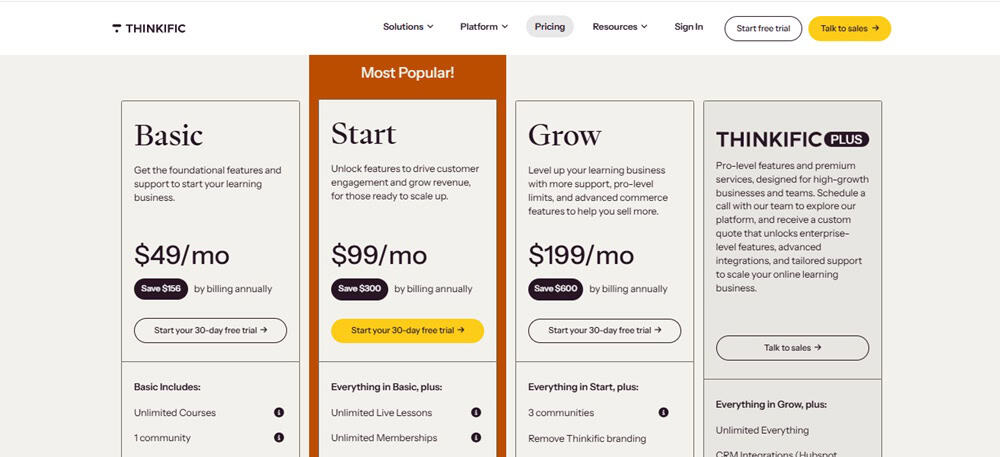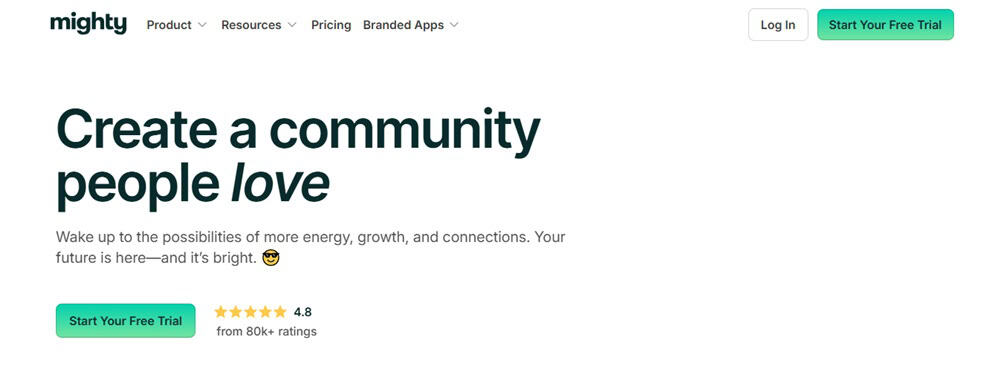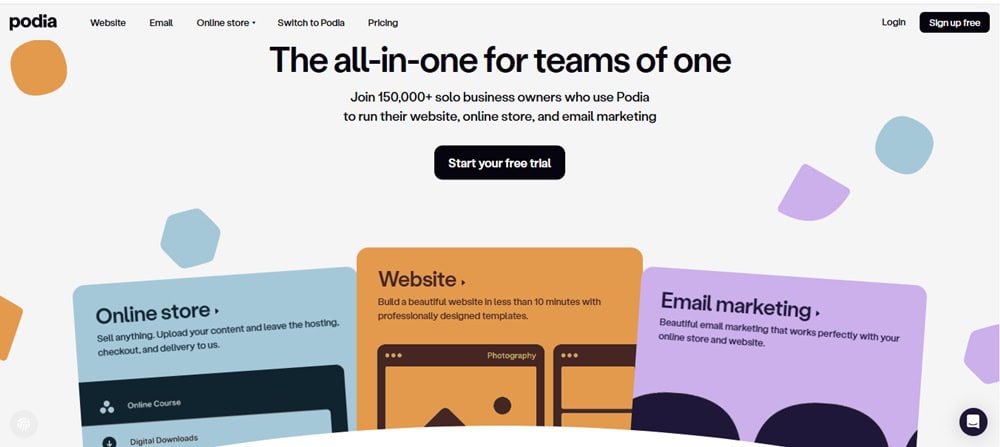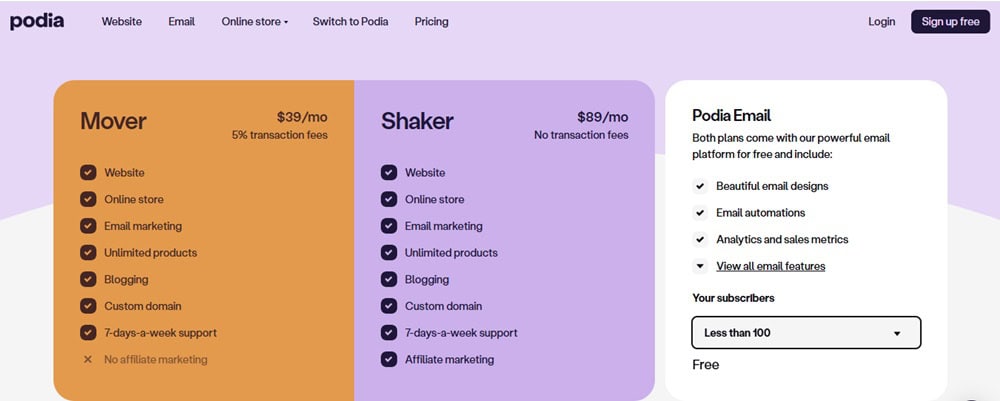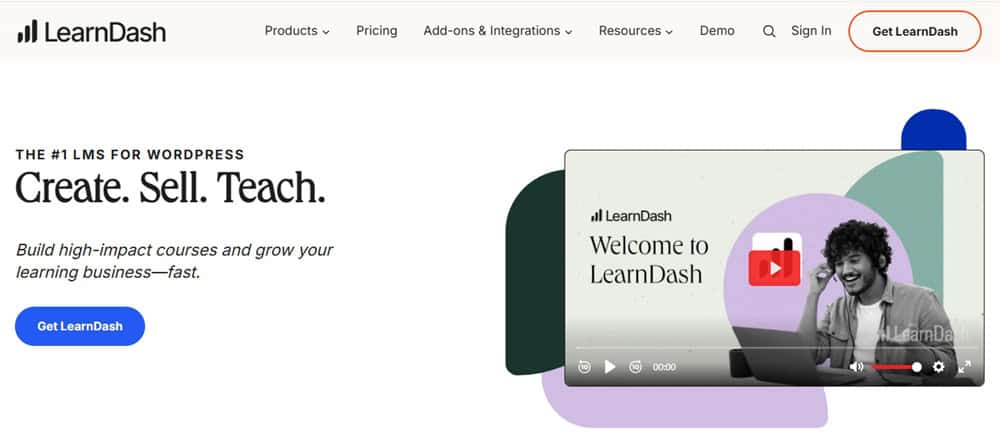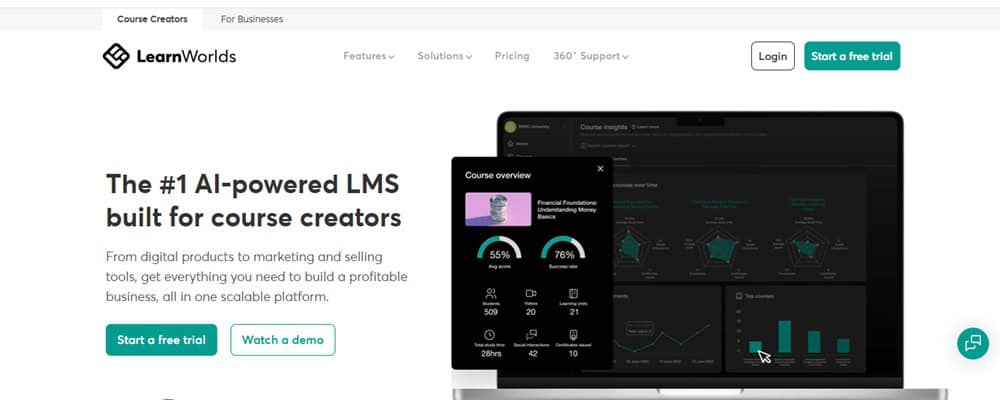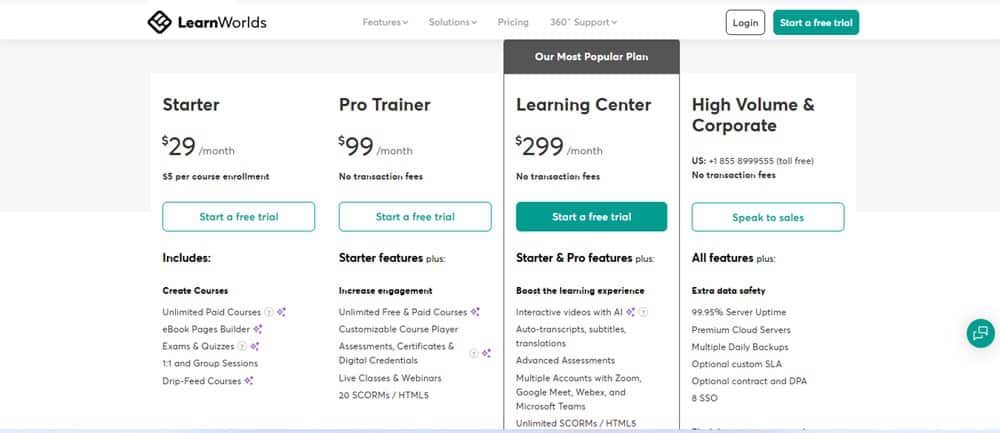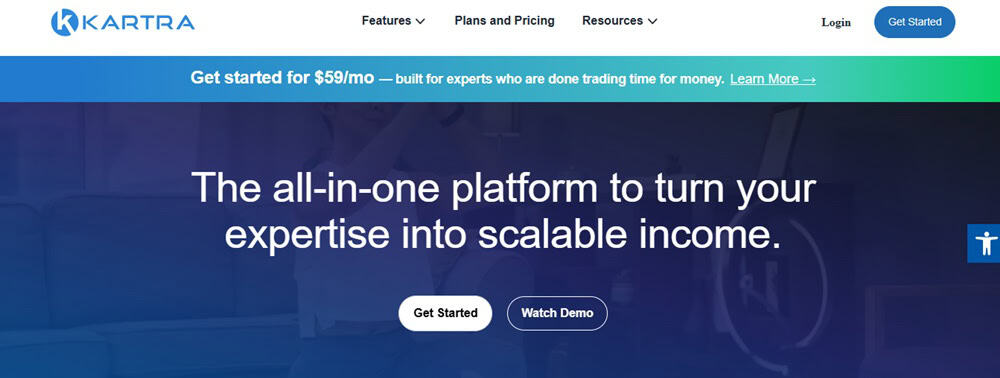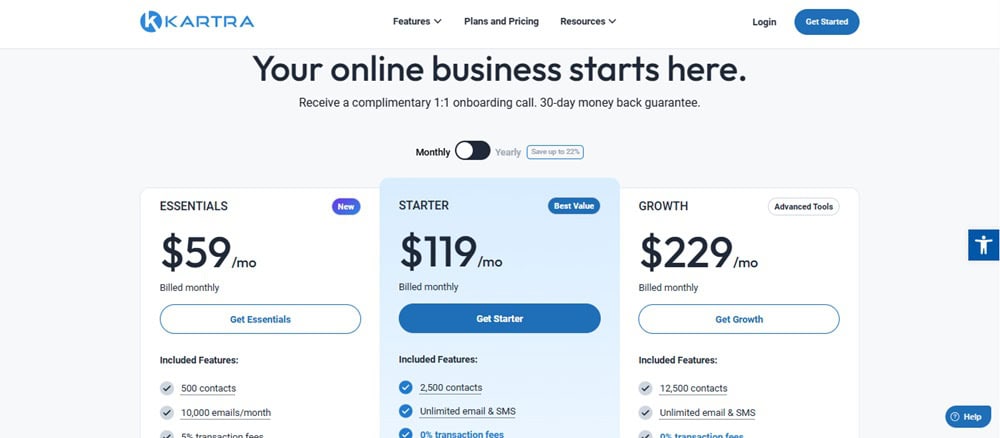KhrisDigital is supported by readers like yourself. We may earn a commission when you purchase through our links (at no extra cost to you).
Ever feel like Teachable just… isn’t quite cutting it? I’ve been there.
Over the past few years, I’ve tested and tinkered with over a dozen course hosting and membership platforms. Trying to find that sweet spot between ease, features, price, and control.
And after all that trial and error, I recently launched my very first low-ticket product (with course hosting built in), using a super simple setup that didn’t cost me a fortune or make me want to scream.
So, if you’re looking for Teachable alternatives, whether you want something more affordable, more flexible, or just less cumbersome, you’re in the right place.
I’m breaking down the best Teachable competitors I’ve personally used, including a few gems you might not know about.
9 Best Teachable Competitors For Your Online Courses
| Alternatives | Free Trial | Starting Price |
|---|---|---|
| Thinkific | 30-day free trial | $49/month |
| Mighty Networks | 14-day free trial | $49/month billed annually |
| Podia | 30-day free trial | $39/month |
| ThriveCart Learn | None | $495 one-time |
| Udemy | Free to use | 37% or 97% revenue share |
| Kajabi | 14-day free trial | $89/month |
| Ruzuku | Free plan | $99/month |
| LearnDash | None | $199/year for one site |
| LearnWorlds | 30-day free trial | $29/month |
| Kartra | 30-day free trial | $59/month |
1. Thinkific: The Best Alternative to Teachable
If Teachable feels a little stiff, Thinkific is like its cooler, more flexible cousin. Launched back in 2012, it has been helping creators turn their expertise into best-selling online courses long before the “everyone has a course” trend gained popularity.
And the best part? It also helps you run the business side of things.
What Makes Thinkific a Great Teachable Alternative?
Thinkific doesn’t drown you in tech headaches. Instead, it gives you tools that make running your course feel less like babysitting software and more like building a real business.
- Look professional from day one: Use your own domain and branding so students see your business, not Thinkific’s logo everywhere.
- Built-in communities: No more herding students into a random Facebook group. Keep engagement inside your platform.
- Build courses quickly: The drag-and-drop builder makes uploading lessons, videos, and PDFs incredibly easy, with no technical skills required.
- Sell smarter, not harder: Run discounts, coupons, bundles, or even memberships to boost your sales without extra software.
- Know what’s working (and what’s not): Track student progress so you can spot where learners drop off and fix it fast.
- Get paid without the headaches: Accept payments directly through Thinkific instead of duct-taping together multiple checkout tools.
- Grow at your own pace: Whether it’s one mini course or a complete online academy, Thinkific scales with your business.
What I Love About Thinkific (Pros)
Here’s where Thinkific really shines compared to Teachable:
- You don’t feel lost in the dashboard. It’s intuitive, even if tech usually makes you want to cry.
- You can build communities and memberships in the same place as your courses.
- Your site looks like your brand, not a cookie-cutter template.
- Works just as well if you’re a coach, course creator, or membership owner.
- It feels reliable. You don’t worry about it going down on launch day.
What I Don’t Like About Thinkific (Cons)
No platform is perfect. Here are the trade-offs:
- The site builder can feel a little “boxy” if you’re picky about design.
- There’s no built-in email marketing, so you’ll need to connect it to your favorite tool.
How Much Does Thinkific Cost?
- Basic ($49/month): Lets you add custom domains, coupons, and no transaction fees. Great for getting serious.
- Start ($99/month): Perfect if you want memberships, bundles, and better engagement tools.
- Grow ($199/month): For when you’re scaling into a full-on online learning platform with advanced analytics and integrations.
- Thinkic Plus: This is a custom plan that provides unlimited access to everything. This plan offers Pro-level features and premium services, specifically designed for high-growth businesses and teams.
2. Mighty Networks: Best for Building a Community-Driven Academy
Mighty Networks is more than a course platform. It began in 2017 as a community-building tool, then evolved into a powerful platform for hosting courses, memberships, and even full-fledged branded academies.
If Thinkific feels like “school,” Mighty Networks feels more like “your own private clubhouse.”
If you’re dreaming about more than just videos and modules, if you want interaction, belonging, and engagement, this one’s worth a serious look.
What Makes Mighty Networks a Great Alternative to Teachable?
Mighty Networks puts community at the heart of everything, then layers courses and monetization on top.
Here’s what that means for you:
- Create your own academy: Build a space where your courses, community, and coaching all live together.
- Keep people engaged daily: Feeds, posts, polls, and events make students want to come back. Not just binge and disappear.
- Host live or pre-recorded content: Whether it’s Zoom-style classes or evergreen video lessons, you can run both within your hub.
- Sell memberships, not just courses: Turn your students into long-term members who stick around month after month.
- Custom-branded mobile app: Your community and courses are literally in your students’ pockets.
- Monetize multiple ways: Sell courses, bundles, groups, or memberships all under one roof.
- Less “tech stack” overwhelm: Community, courses, and payments all on one login, one dashboard, and one monthly bill.
What I Love About Mighty Networks (Pros)
Here’s why this platform feels different from most Teachable competitors:
- It’s engagement-driven and not just about content delivery.
- You can run everything (community, events, and courses) in one place.
- The app makes your business feel like a legit, branded platform.
- Ideal for coaches, cohort-based courses, and membership programs.
- It is super sticky. People stay active way longer than with traditional course platforms.
- Feels modern and designed for how people actually learn and connect today.
What I Don’t Like About Mighty Networks (Cons)
Of course, there are trade-offs:
- The course builder isn’t as advanced as Thinkific or Teachable, it’s more about simplicity than depth.
- Customization for lessons/pages can feel limited.
- Pricing can add up if you want advanced features, such as branded apps.
How Much Does Mighty Networks Cost?
- Community Plan at $49/month billed annually: Just starting out? This plan provides a solid foundation, featuring community engagement, events, livestreaming, and member messaging. Perfect if you’re focused on connection, not courses (yet).
- Courses Plan at $129/month billed monthly (or $109/month billed annually): Ready to teach? This plan allows you to create comprehensive courses, quizzes, and bundles, and sell them as you see fit. The transaction fee is 2%. Think: premium learning experience without tech headaches.
- Business Plan at $229/month billed monthly (or $189/month billed annually): Want more control? This plan unlocks custom branding, email white-labeling, advanced analytics, and powerful integrations. Ideal for serious creators scaling up. The transaction fee is 2%.
- Path-to-Pro (Growth Plan) at $430/month billed monthly (or $360/month billed annually): This is your bridge to the big leagues. You get coaching, strategic support, VIP features, and the lowest transaction fees (just 1%). Ideal if you’re already monetizing and want to grow smarter.
- Mighty Pro (Custom pricing): Going full white-label? You’ll get your own branded mobile app, design support, and a team behind you. Best suited for brands, organizations, or creators with a large audience and an ambitious vision. The transaction fee is 1%.
3. Podia: Best Budget-Friendly Alternative to Teachable
Podia launched in 2014 with one clear mission: make it ridiculously easy for creators to sell digital products without needing a tech team or a stack of tools.
If Teachable feels like “school software,” Podia feels like a friendly little shop where you can sell courses, memberships, digital downloads, and even coaching, all under one roof.
It’s one of the cheaper alternatives to Teachable, and it’s built for people who want to get moving fast without a million integrations.
What Makes Podia a Strong Competitor to Teachable?
- All-in-one setup: You can sell courses, coaching, downloads, and memberships from one dashboard.
- Your own storefront: You can build a clean, customizable site to sell online courses directly from your own website (no need for WordPress unless you prefer it).
- Unlimited everything: Courses, products, students, no caps, no surprise limits.
- Built-in email marketing: You can send newsletters, drip campaigns, and product updates without paying for a separate tool.
- Messaging built in: Students can message you directly, which is excellent for personal support or upsells.
- Simple checkout: Fast, distraction-free checkout that helps you close more sales.
What I Love About Podia (Pros)
Here’s why I think Podia stands out compared to other Teachable competitors:
- It is super clean and simple, you don’t get lost in settings.
- You get unlimited products and students, even on lower plans.
- Email marketing is included, so you don’t have to juggle extra tools.
- There are no transaction fees on the shaker plan.
- Great value if you’re testing low-ticket courses or digital products.
- It is very fast to launch. You can set up a course in just a few hours.
What’s Not So Great About Podia (Cons)
A few limitations you’ll want to keep in mind:
- Course design and customization are basic compared to Thinkific or Kajabi.
- Not as powerful for advanced marketers (funnels, analytics, and automation are limited).
- The mover plan takes a 5% cut, which can add up quickly if you start selling.
How Much Does Podia Cost?
- Mover Plan ($39/month): You get a complete website, unlimited courses, and downloads. A 5% transaction fee applies.
- Shaker Plan ($89/month): This plan lets you add memberships, affiliates, and advanced marketing features. There is no transaction fee with this plan.
- Podia Email: All Podia plans, including the free trial, come with Podia Email included for up to 100 subscribers. You can always add on more subscribers as your list grows. You get to pay $9 for 500 subscribers.
4. ThriveCart Learn: Best for Creators Who Want a Built-In Course Platform with a Killer Checkout
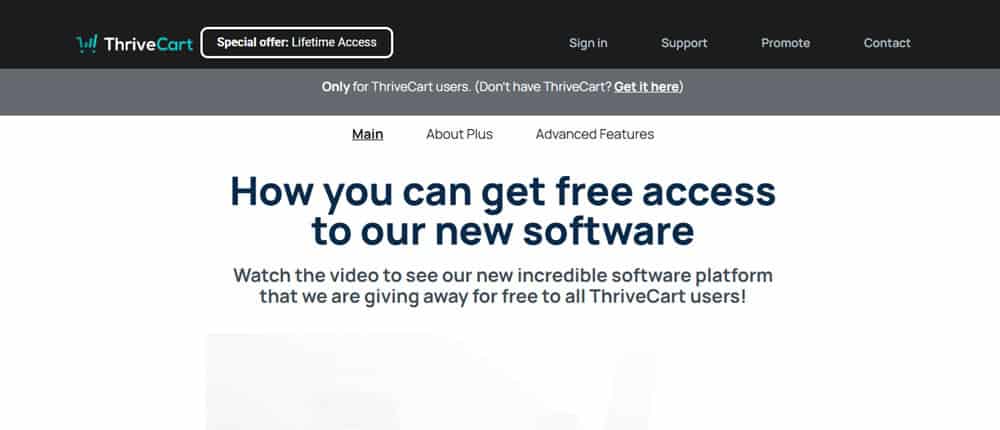
ThriveCart was launched as a powerful checkout system in 2016, renowned for its high-converting carts, order bumps, and upsells.
But when they launched ThriveCart Learn in 2020, they gave creators something even bigger: a simple way to host and deliver courses right inside the same platform.
That means you can sell and deliver your courses in one place, no duct-taping together carts and course platforms.
What Makes ThriveCart Learn a Great Teachable Substitute?
Think of it like having your course platform baked right into one of the best checkout systems out there.
Here’s why that’s a big deal for you:
- Sell smarter, earn more: ThriveCart’s checkout is built to maximize conversions with upsells, order bumps, and A/B testing. Your sales pages literally work harder for you.
- Courses included (no extra cost): Unlike paying monthly for a platform, Learn comes included with ThriveCart, so you’re not stuck with ongoing fees.
- Simple course delivery: Upload content, organize modules, and students get a clean, distraction-free experience.
- Unlimited students and courses: There are no caps on growth, so you can launch mini products or even build a whole academy without extra charges.
- Custom branding: You can make your course area look and feel like your business, not generic software.
- Automated access: Students get instant login after checkout, no juggling integrations. Smooth for them, stress-free for you.
- Lifetime deal option: ThriveCart is one of the few platforms offering lifetime pricing, so you could pay once and avoid monthly bills forever.
What I Love About ThriveCart Learn (Pros)
- The checkout is one of the best in the business, period.
- No monthly subscription (huge win compared to Teachable’s pricing).
- Unlimited courses and students without hidden upgrades.
- Built-in automations make course delivery effortless.
- Perfect if you’re launching low-ticket products, you keep more of your money.
- Combines selling + course hosting in one tool, so less tech to manage.
What I Don’t Like About ThriveCart Learn (Cons)
- Course design is pretty basic compared to Thinkific or Kajabi.
- No native community features (you’d need another tool for that).
- The upfront cost of the lifetime deal can feel steep if you’re starting.
How Much Does ThriveCart Learn Cost?
ThriveCart isn’t a subscription; it’s a one-time payment.
- ThriveCart Lifetime License (~$495 one-time): This gets you the checkout system and ThriveCart Learn, with unlimited courses and students.
- Learn+ Add-on ($195 one-time): This adds advanced features like bundles, student progress tracking, and course templates.
5. Udemy: Best for Instant Access to a Massive Student Marketplace

Udemy has been around since 2010 and has grown into one of the largest online learning platforms in the world. Instead of being just a tool to host your courses, it’s a full-blown marketplace where millions of students are already browsing, searching, and buying.
If building your own audience feels overwhelming, Udemy can put your course in front of thousands of potential buyers overnight.
What Makes Udemy a Great Option?
Udemy works differently from platforms like Thinkific or Podia. Instead of you doing all the marketing, Udemy brings the audience to you.
Here’s what that means in practice:
- Massive built-in audience: Millions of people already search Udemy daily, so your course can get discovered by buyers without you running ads or building a list first.
- Passive sales potential: Once your course is live, Udemy promotes it in sales, bundles, and email campaigns. That means you can keep making sales even while you sleep.
- Global reach: Udemy markets in multiple languages and countries, so your course can reach students worldwide without extra effort.
- Low barrier to entry: You can publish a course for free, with no setup costs, no website required. Great if you want to get started quickly.
- Student trust: Because Udemy is a known platform, people often buy more easily than they do from a random website.
- Marketing handled for you: Udemy runs huge promotions and seasonal sales that bring floods of students in. You don’t pay for ads, they do.
- Social proof built in: Ratings, reviews, and enrollments act like free testimonials that can boost your credibility.
What’s Great About Udemy (Pros)
Here’s why I think Udemy deserves a spot on your radar:
- You don’t need an audience to start selling.
- Udemy’s global marketing power means your course can be seen worldwide.
- It’s low risk — no upfront costs, no tech stress.
- You can use Udemy as a “discovery tool,” then funnel loyal students to your own site later.
- Passive sales are possible once you rank in the marketplace.
- Great place to validate a course idea before investing in a standalone platform.
What I Don’t Like About Udemy (Cons)
That said, there are significant trade-offs with using Udemy:
- Pricing is out of your hands. Udemy often discounts your $100 course down to $9.99.
- You don’t “own” your students, Udemy controls the data and limits how you contact them.
- Revenue share can feel low (typically 37% of the sales Udemy generates).
How Much Does Udemy Cost?
This is where Udemy stands out, it’s free to create and publish your courses.
- No upfront fees: You can upload and launch without paying a dime.
- Revenue share model: Udemy takes a cut of sales. If they bring the student, you usually keep 37%. If you bring the student through your own link, you keep 97% of the revenue.
6. Kajabi: Best All-in-One Teachable Alternative for Serious Creators
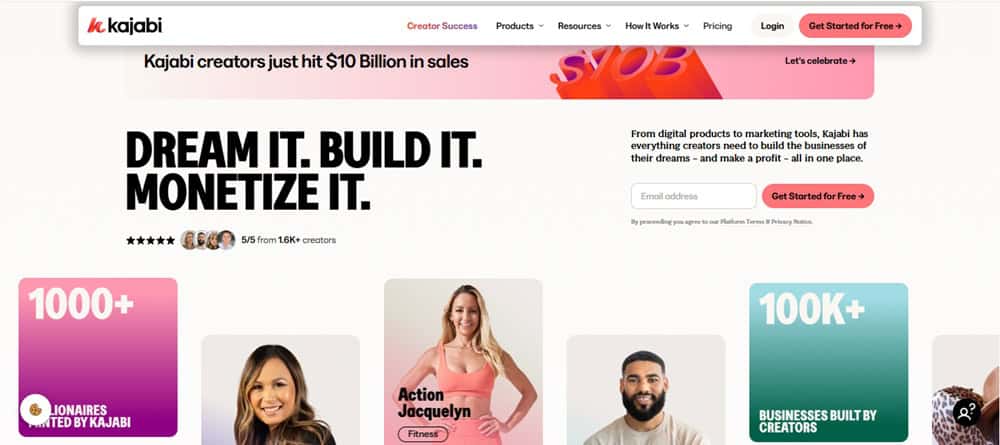
Kajabi launched in 2010 and quickly became the “Rolls-Royce” of online course platforms.
It’s more than a course builder, it’s a complete business platform that lets you run everything from building landing pages to email campaigns to memberships without needing a dozen separate tools.
If you want to stop piecing together tech and actually run your business from one dashboard, Kajabi is where you look.
What Makes Kajabi a Great Teachable Competitor?
Kajabi stands out because it gives you tools that most other platforms don’t, all in one place.
Here’s what that means for you:
- Your entire business under one roof: Courses, memberships, coaching, landing pages, and email marketing all live in one platform. No duct-taping tools together.
- High-converting sales funnels: Build automated sales funnels that attract leads, nurture them, and sell your course without needing ClickFunnels or extra software.
- Built-in email marketing: Kajabi lets you send broadcasts, create automations, and segment your list directly inside.
- Branded, professional websites: Launch a complete website for your business, not just a course portal. It feels like your own academy, not a bolt-on product.
- Community and membership tools: Create thriving student hubs without relying on Facebook groups.
- Automation that saves you time: Trigger emails, offers, or rewards based on student behavior so you can scale without working 24/7.
- Analytics that matter: See revenue, opt-ins, course progress, and campaign performance in one place so you know what’s working.
What I Love About Kajabi (Pros)
Here’s why Kajabi is such a powerful Teachable competitor:
- It replaces half a dozen tools (website builder, email software, course platform, funnel builder, etc.).
- The automation tools let you work smarter, not harder.
- Branding flexibility makes your site feel premium and truly yours.
- You can build best-selling online courses, memberships, and coaching offers together.
- The dashboard feels polished and designed for creators, not coders.
- It’s built for scaling — great if you’re serious about growing a business, not just launching one course.
What I Don’t Like About Kajabi (Cons)
- It’s one of the most expensive platforms out there.
- The advanced features can feel overwhelming at first if you’re brand new.
- If you only want to sell a single low-ticket product, it’s probably overkill.
How Much Does Kajabi Cost?
Kajabi is premium-priced because it replaces multiple tools.
Here’s the breakdown:
- Kickstarter Plan ($89/month): This is perfect if you are a beginner launching your first online business. You get one website, one product+community, 7500 marketing emails, and unlimited landing pages.
- Basic Plan ($149/month): This gives you everything you need to start your business. You get one website, three products, three funnels, unlimited landing pages, a custom domain, and unlimited emails.
- Growth Plan ($199/month): This helps you scale your established business and get serious about growing. You get 15 products, 15 funnels, advanced automations, and better branding controls.
- Pro Plan ($399/month): This helps you scale your business with advanced features. You get three websites, 100 products, 100 funnels, and custom code editing.
7. Ruzuku: Best for Simple, Interactive Teaching Without the Tech Overwhelm
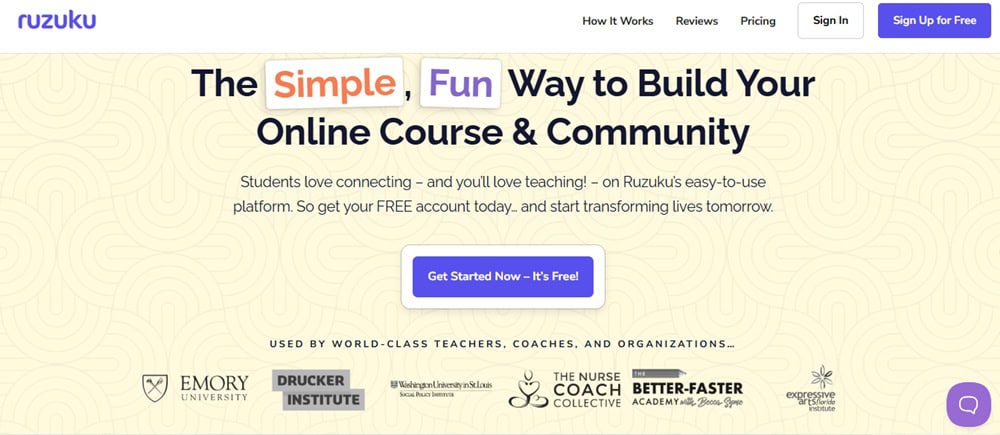
Ruzuku has been around since 2011 and was built with one goal: to make online teaching easy enough that you don’t need to be a “tech person” to get started.
If Teachable sometimes feels stiff or too structured, Ruzuku feels like the friendly, low-stress alternative that lets you set up, go live, and guide your students without fuss.
It’s perfect if you want to blend self-paced learning with live sessions, workshops, or coaching.
What Makes Ruzuku a Great Teachable Alternative?
- Ridiculously easy setup: You can create and launch a course in a day without reading a manual or hiring help.
- Host live events inside your course: Run webinars, workshops, or group calls directly in the platform, no extra Zoom link juggling.
- Interactive student experience: Built-in polls, discussions, and Q&A tools help students feel engaged instead of just watching videos.
- Step-by-step course structure: Perfect for guiding students through a clear path (great for coaching-style programs).
- Unlimited courses and students: You’re not capped as your academy grows.
- Seamless payments: Accept payments directly without complex integrations.
- Focused on teaching, not tech: Less time fiddling with settings, more time creating and connecting.
What I Love About Ruzuku (Pros)
Here’s why Ruzuku stands out from other Teachable competitors:
- There is a free plan
- The learning experience feels guided, rather than just dumping videos.
- Live workshops and webinars are built in, you don’t need separate tools.
- Perfect for coaches and educators who want interaction, not just passive courses.
- Ruzuku is very beginner-friendly. If you hate tech, you’ll actually enjoy using it.
- Unlimited courses and students give you room to grow.
- It keeps things simple. No feature bloat, just what you need to teach well.
What I Don’t Like About Ruzuku (Cons)
That simplicity does come with trade-offs:
- Customization options are limited, you won’t get a flashy, branded site.
- No advanced marketing features like funnels or automations.
- Pricing can feel high compared to Podia or Thinkific, given the simpler feature set.
How Much Does Ruzuku Cost?

- Free Plan: For free, you can host unlimited courses and videos, but you are limited to only five students.
- Core Plan at $99/month: This plan lets you create, sell & teach unlimited online courses to unlimited students and send an unlimited number of course invitations.
- Pro Plan at $199/month: This plan gives you custom domains, branding, the ability to add multiple instructors, and certificates of completion.
8. LearnDash: Best for Full Control With WordPress
LearnDash is a WordPress plugin that turns your site into a full-blown learning management system (LMS). It’s been around since 2013 and is trusted by universities, corporations, and entrepreneurs alike.
If you’ve ever felt boxed in by Teachable’s limitations, LearnDash is the complete opposite. This WordPress plugin is flexible, customizable, and puts you in charge of every detail.
What Makes LearnDash a Great Substitute to Teachable
LearnDash stands out because it gives you the freedom that hosted platforms just can’t. Here’s how that benefits you:
- You own everything: Your site, your content, your students — no relying on third-party platforms that can change the rules or shut you down.
- Ultimate flexibility: Design your site however you want, integrate any tool you love, and control the entire student journey.
- Drip lessons & prerequisites: Create a structured learning path so students follow your course in the exact order you want.
- Gamify learning: Add points, badges, and certificates to keep students motivated and engaged (something Teachable doesn’t offer natively).
- Sell in any way you like: One-time sales, subscriptions, memberships, bundles — all possible with eCommerce integrations like WooCommerce.
- Integrates with everything: Email marketing tools, CRMs, forums, and communities plug right in.
- Scale without limits: Since it’s WordPress, you can host unlimited courses and students without jumping to higher plans.
What I Love About LearnDash (Pros)
- You’re not renting space on someone else’s platform, you own it.
- Branding is entirely yours. No logos, no restrictions, no compromises.
- You can sell online courses from your own website and make it look however you want.
- Gamification makes learning more fun and interactive.
- Ideal for establishing a professional online academy with sophisticated course structures.
- You’re in control of integrations, so it grows with your business instead of limiting you.
What I Don’t Like About LearnDash (Cons)
But the freedom does come with some challenges:
- It’s more hands-on. You need to manage hosting, WordPress, and plugins.
- No built-in checkout — you’ll need WooCommerce, ThriveCart, or another tool for payments.
- If you’re not tech-savvy, setup can feel overwhelming without help.
How Much Does LearnDash Cost?
LearnDash uses a simple yearly pricing model, unlike monthly SaaS platforms:
- 1 Site License ($199/year): Great if you’re running courses on one site.
- 10 Site Licenses ($399/year): Perfect if you’re building multiple course sites or client projects.
- Unlimited Site Licenses ($799/year): For agencies or big academies managing tons of sites.
9. LearnWorlds: Best for Interactive and Engaging Online Courses
LearnWorlds was founded in 2014 and has built a reputation as one of the most advanced course platforms for creators who care about student engagement.
While Teachable focuses on the basics of uploading and selling courses, LearnWorlds goes all-in on interactive learning experiences — giving your students a reason to stay, finish, and rave about your course.
If you want your platform to feel less like “watch a video and leave” and more like a true online academy, this one deserves your attention.
What Makes LearnWorlds a Great Alternative to Teachable
- Interactive videos: Add quizzes, hotspots, and CTAs inside your videos so students stay active, not passive.
- Built-in white-label website builder: Create a fully branded site that feels premium, without needing WordPress or extra tools.
- Student note-taking: Learners can highlight, add notes, and interact with your content, boosting retention and satisfaction.
- Quizzes, tests, and certificates: Turn your course into an authentic learning experience that motivates students to complete it.
- eBook builder: Repurpose content into eBooks and guides directly inside the platform.
- Powerful analytics: Track how students interact with your lessons so you can improve engagement and completion rates.
- SCORM & HTML5 support: If you’re serious about professional training, it integrates seamlessly with corporate standards most platforms ignore.
What I Love About LearnWorlds (Pros)
Here’s why I think LearnWorlds is one of the best Teachable competitors:
- The interactive video feature is a game-changer. No more boring “press play and zone out.”
- You get a true “academy feel” with tests, certificates, and structured learning paths.
- Student note-taking tools make the learning experience way more engaging.
- Analytics go deeper than “who finished”, you see how people interact with your content.
- White-label branding makes your site look 100% yours.
- It’s built to scale for both solo creators and professional training businesses.
What I Don’t Like About LearnWorlds (Cons)
As powerful as it is, there are a few downsides:
- The dashboard can feel overwhelming if you only want something simple.
- Some features (like interactive video) are locked behind higher-tier plans.
How Much Does LearnWorlds Cost?
- Starter Plan ($29/month): Basic features, but a $5 fee per course sale. Good for testing.
- Pro Trainer ($99/month): There are no transaction fees, plus quizzes, certificates, and white-label options.
- Learning Center ($299/month): You get interactive video, advanced analytics, and SCORM support.
- High-Volume & Corporate Plans (Custom): This plan is best for enterprises needing advanced training setups.
10. Kartra: Best for All-in-One Marketing and Course Delivery
Kartra was launched in 2018 and quickly became known as one of the most comprehensive online business platforms available.
It’s not just about hosting courses — it’s about building a system that attracts leads, nurtures them, and turns them into paying (and repeat) students.
If Teachable feels like a one-trick pony, Kartra is the full circus.
What Makes Kartra a Great Competitor?
Kartra combines course hosting with powerful marketing tools that many other Teachable competitors lack.
Here’s what that means for you:
- Build full websites & funnels: Instead of just course pages, you can create entire websites, blogs, or multi-step funnels that sell your courses on autopilot.
- Powerful email automation: Replace tools like Mailchimp or ConvertKit. Tag leads, send sequences, and personalize emails based on student behavior.
- Membership sites built-in: Run structured courses or membership communities without bolting on extra apps.
- High-converting checkout pages: Optimize every sale with order bumps, upsells, downsells, and payment plans.
- Video hosting included: Upload and deliver videos directly, with built-in analytics (no need for Vimeo or Wistia).
- Affiliate management system: Recruit affiliates and let others promote your courses, all tracked automatically.
- One dashboard for everything: No juggling 10 different tools. Courses, emails, funnels, payments, and analytics all live in Kartra.
What I Love About Kartra (Pros)
- It’s a true all-in-one; you don’t need separate tools for funnels, emails, or affiliates.
- Perfect for building online courses with advanced marketing.
- Email automation is insanely powerful compared to Teachable’s barebones setup.
- You can sell multiple products (courses, coaching, memberships) from the same system.
- Video hosting is included, which saves extra money.
- Scaling is easy since everything is built to work together.
What I Don’t Like About Kartra (Cons)
That said, there are a few drawbacks to keep in mind:
- The learning curve can feel steep if you’re brand new.
- The interface isn’t as “pretty” as Podia or Kajabi.
- Pricing is higher than starter-friendly platforms.
Kartra Pricing
- Essentials at $59/month: Just getting started? This plan’s your launchpad: 500 contacts, 1 product, and all the core tools to build your first funnel and test the waters.
- Starter at $119/month: Ready to grow? You get 2,500 contacts, unlimited pages and products, no transaction fees, and full access to Kartra’s magic—including AI, analytics, and video hosting.
- Growth at $229/month: Got momentum? This plan ramps it up with webinars, quizzes, affiliate tools, advanced automations, and 12,500 contacts. Ideal if your biz is scaling fast.
- Professional at $549/month: Running the show? This gives you the full-blown toolkit—real-time analytics, 25K contacts, five custom domains, team features, and every bell + whistle you’ll need.
- Enterprise for a Custom price: Doing BIG things? Reach out for a custom setup built to fit your empire.
Why You Might Be Searching for Teachable Alternatives (And You’re Not Alone)
Teachable sounds great on paper. But once you’re in the trenches trying actually to sell online courses from your own website, reality hits a little differently.
Here are some legit reasons creators like you start looking for a cheaper alternative to Teachable or scroll through every list of online learning platforms hoping to find “the one”:
1. The Pricing Feels… A Lot
Teachable’s pricing structure is one of the biggest reasons people bounce.
Sure, there’s a free plan. However, it comes with Teachable branding throughout your content, no custom domains, and, worst of all, they take $1 + 10% per transaction.
Let’s say you sell a $10 course. You walk away with just $8 after Teachable’s cut, and that’s before payment processor fees.
Move up to the Starter plan? That’s $39/month, and they still take 7.5% of every sale. Want to remove transaction fees completely? Now you’re at $89/month.
For creators just starting or launching low-ticket offers, like I did, that pricing model quickly eats into your margins. It feels like you’re paying for features you don’t fully use yet, to look credible.
2. Customer Support That Disappears When You Need It Most
When you’re mid-launch and something breaks, such as your checkout page not loading or students being unable to access their course, you need help quickly.
But with Teachable, support often feels like shouting into the void.
On the Starter plan, you only get email support (no live chat), and even then, replies can take a full day or more. That might be okay if you’re not in a rush.
But if you’re running a promo, onboarding new students, or fixing a bug that’s costing you sales, slow support becomes a real business risk.
I once experienced a payment integration issue that lasted four days! Four days of lost sales and unanswered emails. That was my wake-up call.
3. Feature Gaps That Force You to Pay for More Tools
Teachable covers the basics — course creation, payments, drip content. However, once you start growing, you quickly encounter limitations.
Want to build a real coach online course platform with private communities, upsells, or student progress tracking? You’re either paying for a third-party tool or realizing those features don’t exist on your current plan.
There’s no native community feature (unless you’re on Starter or higher), affiliate marketing tools are limited, and the design options are minimal. It can feel like your platform’s holding you back.
If you’re dreaming of building your own branded experience — to create your own academy, host coaching programs, or even bundle in other digital offers — Teachable just isn’t designed for that kind of flexibility.
Real-World Things to Consider Before Choosing a Teachable Substitute
Choosing the right platform isn’t just about “which one is popular.”
It’s about finding something that matches your style, your business model, and the way you want to work now and in the future.
Here’s what to really think about before committing:
1. Your Comfort with Tech (and How Hands-On You Want to Be)
Some platforms are ready to go in minutes, others need you to tinker with plugins, integrations, or embed codes to launch a course.
Ask yourself:
- Do you want something all-in-one and done for you?
- Or are you okay piecing together your stack with WordPress, course plugins, and external tools?
If technology frustrates you, simplicity can save you a great deal of time and energy.
But if you’re a builder type who loves having control, a more customizable option might be your jam — like setting up your site with WordPress and using the LearnDash plugin to create your own academy from scratch.
2. The Type of Course (or Offer) You’re Selling
One-size-fits-all doesn’t really exist here.
Selling a $27 mini course is a whole different game than running a $997 group coaching program or a monthly membership.
Ask:
- Are you offering a single course or multiple courses?
- Do you want to bundle products?
- Do you need payment plans or subscriptions?
- Will you also offer one-on-one coaching?
For example, if you want a course platform with student tracking, progress check-ins, and community, you’ll need more than a basic video player and payment page.
3. Content Delivery: How Do You Want to Teach?
The way you teach should shape the platform you choose.
Are you:
- Uploading pre-recorded videos?
- Teaching live over Zoom?
- Offering downloadable guides or templates?
- Dripping content over time?
- Hosting cohort-based launches?
Some platforms specialize in self-paced learning. Others shine with live experiences, interactive assignments, or structured programs.
Ensure the platform aligns with the learning experience you’re trying to create, not just what looks good in the demo.
4. Branding and Student Experience
This part often gets overlooked, but it’s what separates you from looking like “just another course.”
Ask:
- Can you use your own domain (not something.teachable.com)?
- Can you eradicate platform branding?
- Can you customize the layout, design, and emails?
- Does the dashboard feel premium, or outdated?
If you’re building an authentic brand and want people to feel like they’re entering your world, this stuff matters.
Especially if you want to sell online courses from your own website and not be limited by someone else’s interface.
5. Sales, Marketing, and Automation Tools
You can have the best course in the world, but if your platform doesn’t help you sell it, what’s the point?
Here’s what to look for:
- High-converting checkout pages (with upsells, order bumps, or coupons)
- Email marketing built-in or easy integrations
- Affiliate tracking
- Abandoned cart recovery
- Landing page or funnel builders
The less you have to duct-tape together third-party tools, the smoother your setup, and the more profit you keep. This becomes especially important if you’re planning to launch low-ticket digital products where margins are crucial.
6. Total Cost (Not Just Monthly Fees)
Let’s talk money.
The platform might say it’s “free” or $29/month — but what about:
- Transaction fees (some take 5–10% per sale)
- Cost of required add-ons (email, webinars, hosting, etc.)
- Student or product limits
- Upgrade costs when your course takes off
Always zoom out and calculate the real cost. Sometimes, a slightly more expensive plan with everything included ends up being cheaper than a “free” one that charges you to breathe.
This is especially key when comparing free Teachable alternatives. Not all free options are created equal.
7. Support and Community: Who Has Your Back?
Look, things break. Confusing settings happen. Integrations stop syncing.
When they do, what kind of support is it like?
- Do they offer live chat, or just email?
- Are replies fast and actually helpful?
- Is there a creator community or FB group to learn from?
- Are there tutorials, guides, or a support library?
If you’re stuck during launch or lose access during a promo, bad support isn’t just annoying, it’s expensive.
A responsive team can be the difference between a successful launch and a stressful flop.
Final Thoughts on Teachable Alternatives
Picking the “perfect” platform can feel like trying to choose your favorite snack at a never-ending buffet.
Overwhelming, right?
However, you don’t need perfect, you need something that actually works for you.
If Teachable’s not quite clicking, Thinkific is hands-down the best alternative out there. It’s cleaner, more flexible, has a solid free plan, and doesn’t nickel-and-dime you on features. Whether you’re just getting your first course out or already making sales, it’s got your back without the bloat.
But whatever you choose—Thinkific, Teachable, Kartra, Mighty Networks—start simple. Don’t wait for “ready.” Just build, test, tweak, and keep showing up.
Because of your course? Your community? Your message? It’s worth building right.
Frequently Asked Questions on Teachable Alternatives
What’s better than Teachable?
For simplicity and affordability, Thinkific is a strong alternative to Teachable. If you’re focused on community-building alongside your courses, Mighty Networks is a top pick. Want an all-in-one marketing and sales powerhouse? Kartra gives you serious automation and funnels.
Can I use Teachable for free?
Yes, Teachable does offer a free plan, but it’s pretty limited. You’ll pay $1 + 10% on every transaction, and you won’t get access to most features like custom branding or advanced marketing tools. It’s fine for dipping your toes in, but not ideal long-term if you plan to scale.
Is Teachable or Thinkific better?
If you want a cleaner design and easier setup, Thinkific wins. It’s super user-friendly and has a solid free plan. But if you’re more focused on monetizing and using built-in marketing tools, Teachable might suit you better.
Check out other Related posts:



